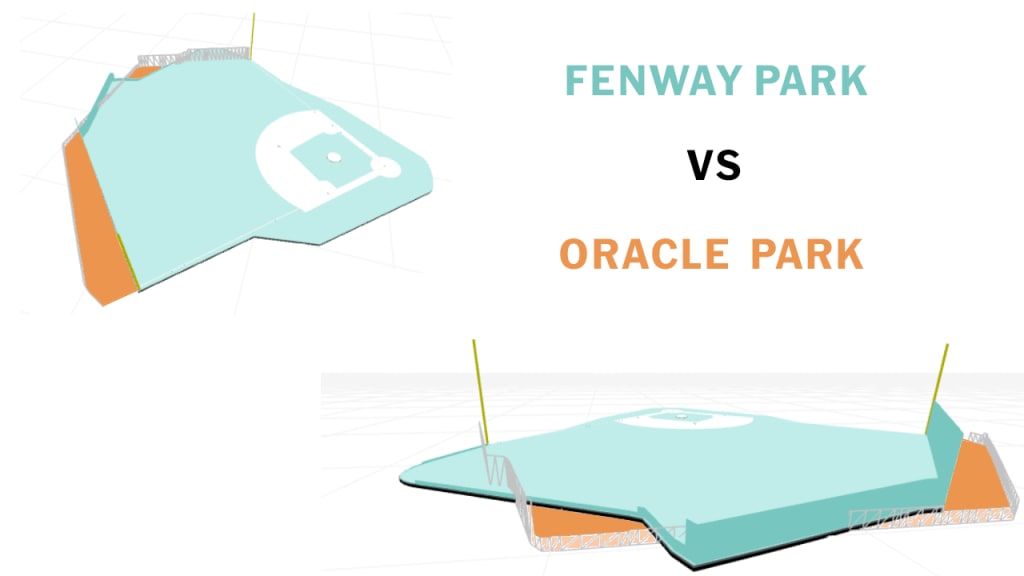Rafael Devers, who was moved off third base due to the presence of a superior defensive option in Boston (Alex Bregman), just got traded to a situation where he almost certainly won’t play third base due to the presence of a superior defensive option (Matt Chapman, when healthy). That’s a deliciously ironic situation that’s going to be subject to a great deal of analysis for the next few weeks (months? years?) so let’s focus on something more near-term:
The Giants, who (in?)famously have not had a 30-homer batter since the last time Barry Bonds did it in 2004, just acquired one of the more lethal bats in the Majors – and he’s going from a home park that has a lot of extremes to another home park that has a lot of extremes.
Now that’s a lot to unpack, too.
It’s not just that the Giants haven’t had a 30-homer batter in more than two decades, of course. It’s how many other teams have. There have been 541 such seasons since 2005 – there are 27 players who have done it at least five different times – and exactly zero of those have come wearing the black and orange by the Bay. (Brandon Belt would have done it in 2021, when he hit 29 in 97 games around a variety of injuries, but he didn’t.)
Devers owns three of them, in 2019, 2021, and 2023, and he’s halfway towards doing it again this season. Since that last Bonds season, the Giants have the second-fewest homers of any team, and nearly 1,500 fewer than the Yankees. Now, they've added a slugger who owns a top-10 hard-hit rate – he’s in a virtual tie with Aaron Judge. Over the last five seasons, only seven hitters own more home runs than his 141. So that’s it, right? Streak over? Sort of. We have to look at this both from the team’s point of view – and the player’s. It's not exactly the same.
It's good for the Giants. Of course.
Well, obviously. While Oracle Park is the primary reason for that lack of homers – it is, as we’ll get to shortly, a somewhat miserable place for power – it’s also a little about the fact that the Giants just haven’t employed a lot of big thumpers over the years. Whether that’s about organizational preference or a belief that the park effects are so powerful that it makes more sense to prioritize other skills is unclear, but it’s also inarguable.
We’re now in the 11th season of Statcast tracking. Among the 30 teams, the Giants have the fourth-weakest team hard-hit rate in that time; they’ve had exactly one player manage a hard-hit rate above 50% in a season with at least 400 plate appearances, and that was Joc Pederson, who did it in both 2022 and ‘23.
If we’re getting a little fancier with “expected quality of contact,” then they’re fifth-weakest. It’s part of why they tried so hard to get Judge and Carlos Correa; this team simply hasn’t had pop in a long time. When you're not making a lot of loud contact, as a team, you're not going to find homers no matter which park you call home.
Enter Devers, who would have single-handedly rewritten the team’s hard-hit leaderboards (going back to 2015) had he been there. In fact, just take a look at what that list would look like now, combining Devers and all other Giants.
Giants hard-hit rate leaders (plus Devers), 2015-present
- 56% // Devers, 2025
- 55% // Devers, 2023
- 53% // Devers, 2024
- 52% // Devers, 2021
- 52% // Pederson, 2023
- 52% // Pederson, 2022
- 51% // Devers, 2022
- 49% // Devers, 2019
- 48% // Matt Chapman, 2024
If part of the drought is simply not having bats with the slug to do it, then that's all different now. Devers possesses elite pop in a way few Giants since Bonds have been able to boast.
It might not be so obviously good for Devers.
Fenway is viewed as being a poor park for lefty power hitters, in part because of how deep it is in right-center field anywhere other than the Pesky Pole down the right field line. So far as home runs go, that’s true; looking at three-year Statcast park factors (as every number we’ll reference here will be), it ranks only 21st in home run factor, with a score of 90 meaning “10% worse than Major League average.”
It’s true for Devers, too. More than half of his career homers (120) have come away from home (where he’s hit 95).
But there’s a few things happening here, too.
First, he’s not exactly going to a more favorable hitting park. If Fenway is 21st in lefty home run factor, then Oracle is 27th, or second-weakest of the 28 parks that have been in use for all three years. While it’s indeed true that the right field bleachers in Fenway are deep, there’s a pretty big chunk of right-center field that’s deeper in San Francisco – and while the 24-foot foot wall in right isn’t the 37-foot Green Monster, it’s still 24 feet high. (In addition to how much extra space in left field San Francisco has, though with a much shorter wall.)

But while we’re talking about whether he can finally be a 30-homer Giants hitter – and we’re talking about hitting 30 in a Giants uniform, not just getting 15 more this season to reach a combined 30 – there’s more to park factors than just long balls, too.
Going back to those three-year park factors, for lefties, the overall rankings are perhaps surprising. Again, just out of 28 parks in use all three years …
- 2nd-best: Fenway Park
- 2nd-worst: Oracle Park
... Boston is actually a tremendous place to hit, for lefties. San Francisco is ... not that.
Neither park is terribly great for lefty home runs, but the big difference here is that Fenway is the best park in baseball for lefty doubles (a 143 park factor, where 100 is average, because remember that lefties like Jarren Duran can take advantage of the Monster too), while Oracle is 15th, almost exactly average. Fenway is a little better for homers and a lot better for doubles. It’s a little about the weather – though it’s not like Boston isn’t also cold early and late in the season – and a lot about the dimensions.
Which tracks with what we’ve already seen from Devers over the last two seasons.
- Home (2024-’25): .961 OPS // .272 AVG // 100 XBH
- Road (2025-’25): .809 OPS // .247 AVG // 46 XBH
It’s why, mostly, that according to Statcast estimates, if he’d played his entire career in Oracle Park, he’d have had … exactly as many homers as he would have had in Fenway Park, with environmental impacts accounted for.
So will Devers break the 30-homer drought, starting next year? He's certainly more likely to do it than anyone the Giants have employed in 20 years, perhaps going all the way back to Bonds himself. Hitting the ball really, really hard certainly goes a long way towards overcoming any ballpark factors, for the most part.
It's not guaranteed, though. It's a really hard place to hit for power. You probably don't have your team go two decades without a 30-homer season by accident.
